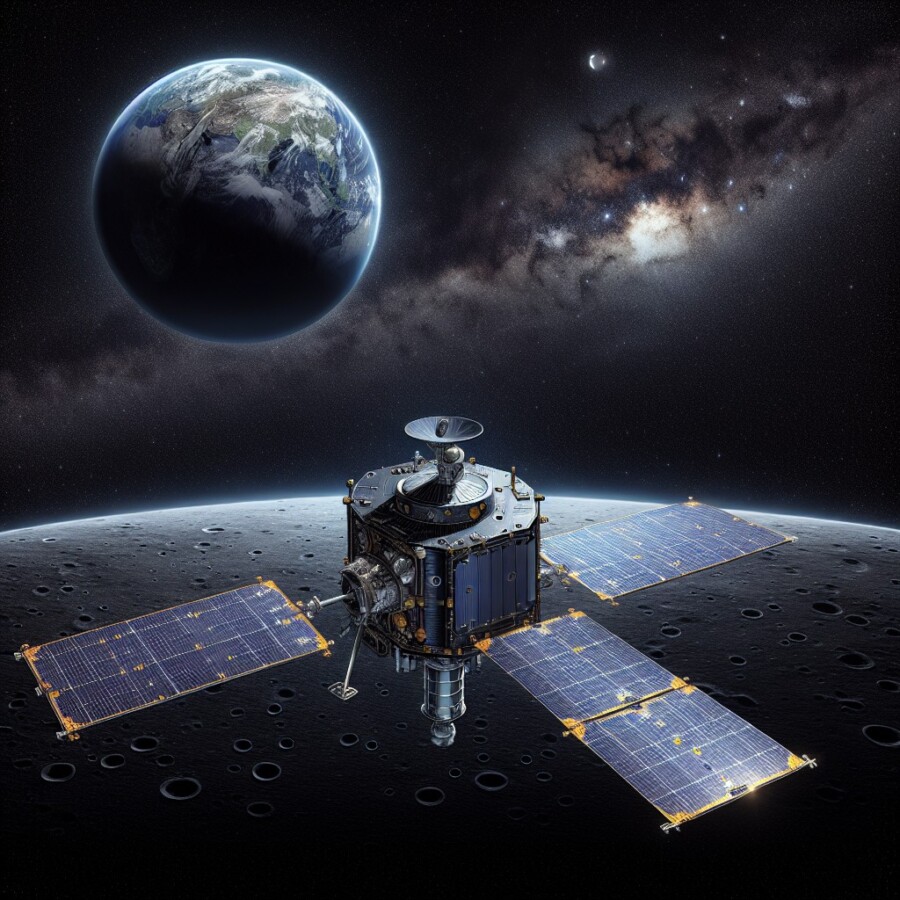Last week, an American spacecraft called Peregrine One tried to land on the Moon, but it didn’t work out. There was a problem with the engine that stopped it from landing. So, the people in charge decided to make the spacecraft destroy itself by entering Earth’s atmosphere and burning up over the Pacific Ocean. A tracking station in Australia confirmed that they lost contact with the spacecraft. It’s unlikely that any parts of it will survive and make it to the ocean.
The company in charge of the mission, Astrobotic, wanted to deliver five instruments from NASA to study the Moon’s environment. If it had worked, this would have been the first American mission in 50 years and the first time a private company landed on the Moon. But they ran into some problems right after launching. Even though things were tough, the engineers were able to figure out what went wrong and make the spacecraft last longer than they thought it would. They were able to fix some things and send it back to Earth. Even though they didn’t reach their main goal, it’s still really impressive what they were able to do.
The problem with the spacecraft was that some of the fuel was leaking from a tank. This made the spacecraft unstable and the solar panels couldn’t keep it powered. But even with all these issues, some of the instruments on board were still able to work and collect data. They learned about the radiation between Earth and the Moon. One of the instruments, called the Peregrine Ion Trap Mass Spectrometer, did really well in tests and might get to go on future missions to the Moon.
Astrobotic is the first of three American companies working with NASA to send a lander to the Moon this year. NASA is paying these companies to help with future missions to the Moon. Astrobotic will get another chance later this year to try landing on the Moon with a NASA rover called Viper. Another company called Intuitive Machines will also try landing on the Moon next month. All of these missions are part of a bigger plan to explore and study the Moon’s surface.
Original news source: Peregrine lander: American Moon mission destroyed over Pacific Ocean (BBC)
🎧 Listen:
Slow
Normal
Fast
📖 Vocabulary:
| 1 | spacecraft | A vehicle designed for travel or operation in outer space |
| 2 | engine | A machine that uses energy to produce motion |
| 3 | atmosphere | The layer of gases surrounding the Earth |
| 4 | tracking | Monitoring and recording the path or movements of something |
| 5 | instruments | Tools or devices designed for scientific purposes |
| 6 | environment | The natural surroundings where living things exist |
| 7 | engineers | People who design, build, and maintain machines and structures |
| 8 | unstable | Not steady and likely to fall or change |
| 9 | solar panels | Devices that convert sunlight into electrical energy |
| 10 | radiation | Harmful energy from the sun or other sources that can’t be seen |
| 11 | spectrometer | An instrument that measures the different parts of a substance |
| 12 | data | Information collected for analysis or reference |
| 13 | lander | A vehicle designed to land on a celestial body, like the Moon |
| 14 | rover | A vehicle designed for traveling on the surface of a planet or moon |
| 15 | surface | The outer layer or top part of something, like the ground or a table |
Group or Classroom Activities
Warm-up Activities:
– News Summary
Instructions: Divide the class into pairs or small groups. Give each group a few minutes to read the article silently. Then, have them work together to write a brief summary of the key points of the article. After they have finished, ask each group to share their summary with the class.
– Opinion Poll
Instructions: Give each student a sheet of paper and ask them to write down their opinion on the following question: “Do you think the Peregrine One mission was a success or a failure? Why?” Once everyone has written their opinion, collect the sheets and shuffle them. Then, distribute the sheets randomly to the students, making sure that no one receives their own paper. Instruct the students to read the opinion they received and discuss it with a partner, either agreeing or disagreeing and providing reasons for their stance.
– Vocabulary Pictionary
Instructions: Write a selection of key vocabulary words from the article on the board. Divide the class into two teams. Call up one student from each team and show them a vocabulary word. They must then draw a quick sketch of the word on the board, without using any letters or numbers. The rest of their team must guess the word based on the drawing. The team that guesses correctly gets a point. Continue until all the words have been drawn.
– Pros and Cons
Instructions: Divide the class into small groups. Give each group a few minutes to discuss and list the pros and cons of the Peregrine One mission. After they have finished, ask each group to share their lists with the class. Facilitate a class discussion about the different points raised, encouraging students to provide reasoning and examples to support their opinions.
– Future Predictions
Instructions: In pairs or small groups, ask the students to discuss and make predictions about the future of space exploration based on the information in the article. Prompt them with questions such as: “What do you think will be the next big breakthrough in space exploration?” and “Do you think private companies will play a bigger role in space missions in the future?” After they have finished discussing, invite a few groups to share their predictions with the class and facilitate a short class discussion.
🤔 Comprehension Questions:
1. What happened to the American spacecraft Peregrine One when it tried to land on the Moon?
2. Why did the people in charge decide to make the spacecraft destroy itself?
3. Where did the tracking station confirm that they lost contact with the spacecraft?
4. What was the main goal of the mission led by Astrobotic?
5. What were some of the problems the engineers faced after launching the spacecraft?
6. What caused the spacecraft to become unstable?
7. Which instrument on board the spacecraft performed well in tests?
8. How many American companies are working with NASA to send a lander to the Moon this year?
Go to answers ⇩
🎧✍️ Listen and Fill in the Gaps:
Last week, an American (1)______ (2)______ Peregrine One tried to land on the Moon, but it didn’t work out. There was a problem with the engine that stopped it from landing. So, the people in charge decided to make the spacecraft destroy itself by (3)______ Earth’s atmosphere and burning up over the Pacific (4)______. A tracking station in Australia confirmed that they lost contact with the spacecraft. It’s unlikely that any parts of it will survive and make it to the ocean.
The company in charge of the mission, Astrobotic, (5)______ to deliver five instruments from NASA to (6)______ the Moon’s environment. If it had worked, this would have been the first American mission in 50 years and the first time a private company landed on the Moon. But they ran into some problems right after launching. Even though things were tough, the engineers were able to figure out what went wrong and make the spacecraft last longer than they (7)______ it would. They were able to fix some things and send it back to (8)______. Even though they didn’t reach their main goal, it’s still really impressive what they were able to do.
The problem with the spacecraft was that some of the fuel was leaking from a tank. This made the spacecraft unstable and the (9)______ panels couldn’t keep it powered. But even with all these issues, some of the (10)______ on (11)______ were still able to work and collect data. They learned about the (12)______ between Earth and the Moon. One of the instruments, called the Peregrine Ion Trap Mass Spectrometer, did really well in tests and might get to go on future (13)______ to the Moon.
Astrobotic is the first of three American companies working with NASA to send a lander to the Moon this year. NASA is paying these companies to help with future missions to the Moon. Astrobotic will get another chance later this year to try landing on the Moon with a NASA (14)______ called (15)______. Another company called Intuitive (16)______ will also try landing on the Moon next month. All of these missions are part of a bigger plan to explore and study the Moon’s surface.
Go to answers ⇩
💬 Discussion Questions:
Students can ask a partner these questions, or discuss them as a group.
1. What do you think about the idea of a private company landing on the Moon?
2. How would you feel if you were part of the team working on the spacecraft and it didn’t work out?
3. Do you think it’s important for humans to explore and study the Moon? Why or why not?
4. What is a tracking station and what do you think its role is in space missions?
5. How do you think the engineers felt when they were able to fix some of the problems with the spacecraft?
6. Do you like the idea of future missions to the Moon? Why or why not?
7. What do you think the engineers learned from this mission that will help them in future missions?
8. How would you feel if you were chosen to go on a mission to the Moon?
9. What is a private company and how is it different from a government agency like NASA?
10. Do you think it’s important for NASA to work with private companies for space missions? Why or why not?
11. How do you think the scientists felt when they were able to collect data even with all the problems the spacecraft had?
12. What do you think the scientists hope to learn from studying the Moon’s environment?
13. How would you feel if you were one of the instruments on board the spacecraft and you were still able to work despite the problems?
14. What is a rover and what do you think its role is in space missions?
15. Do you think humans will ever be able to live on the Moon? Why or why not?
Individual Activities
📖💭 Vocabulary Meanings:
Match each word to its meaning.
Words:
1. spacecraft
2. engine
3. atmosphere
4. tracking
5. instruments
6. environment
7. engineers
8. unstable
9. solar panels
10. radiation
11. spectrometer
12. data
13. lander
14. rover
15. surface
Meanings:
(A) Devices that convert sunlight into electrical energy
(B) The natural surroundings where living things exist
(C) A vehicle designed to land on a celestial body, like the Moon
(D) Information collected for analysis or reference
(E) A machine that uses energy to produce motion
(F) Tools or devices designed for scientific purposes
(G) Harmful energy from the sun or other sources that can’t be seen
(H) Monitoring and recording the path or movements of something
(I) People who design, build, and maintain machines and structures
(J) The outer layer or top part of something, like the ground or a table
(K) A vehicle designed for travel or operation in outer space
(L) Not steady and likely to fall or change
(M) An instrument that measures the different parts of a substance
(N) The layer of gases surrounding the Earth
(O) A vehicle designed for traveling on the surface of a planet or moon
Go to answers ⇩
🔡 Multiple Choice Questions:
1. What happened to the American spacecraft Peregrine One?
(a) It failed to land on the Moon.
(b) It successfully landed on the Moon.
(c) It crashed into the Pacific Ocean.
(d) It was destroyed by a tracking station in Australia.
2. What did the engineers do when they encountered problems with the spacecraft?
(a) They abandoned the mission and returned to Earth.
(b) They fixed some things and sent it back to Earth.
(c) They decided to continue with the mission despite the problems.
(d) They lost contact with the spacecraft and gave up.
3. What was the main problem with the spacecraft?
(a) The engine malfunctioned.
(b) Fuel was leaking from a tank.
(c) The solar panels were not working.
(d) The instruments on board were faulty.
4. What did the instruments on board the spacecraft manage to do?
(a) Collect data on the radiation between Earth and the Moon.
(b) Fix the fuel leak and stabilize the spacecraft.
(c) Land successfully on the Moon’s surface.
(d) Transmit signals to the tracking station in Australia.
5. What is the name of the instrument that performed well in tests and might be used in future missions?
(a) Astrobotic Rover.
(b) Viper.
(c) Peregrine Ion Trap Mass Spectrometer.
(d) Intuitive Machines.
6. How many American companies are working with NASA to send a lander to the Moon this year?
(a) Five.
(b) Two.
(c) One.
(d) Three.
7. What is the purpose of these missions to the Moon?
(a) To search for signs of extraterrestrial life.
(b) To establish a permanent human colony on the Moon.
(c) To explore and study the Moon’s surface.
(d) To test new spacecraft technology.
8. When will Astrobotic get another chance to try landing on the Moon?
(a) Next month.
(b) In 50 years.
(c) They will not get another chance.
(d) Later this year.
Go to answers ⇩
🕵️ True or False Questions:
1. The mission was led by a company called Astrobotic, which aimed to deliver five instruments from NASA to study the Moon’s environment.
2. Despite encountering problems, the engineers were able to extend the spacecraft’s lifespan by fixing some issues and sending it back to Earth.
3. Due to the engine issue, the spacecraft was unintentionally destroyed by entering Earth’s atmosphere and burning up over the Pacific Ocean.
4. Although the main goal was not achieved, the mission was still impressive in terms of what was accomplished.
5. A tracking station in Australia denied that contact with the spacecraft was lost.
6. This would have been the first American mission to the Moon in 50 years and the first time a private company landed on the Moon.
7. It is likely that some parts of the spacecraft will survive and reach the ocean.
8. An American spacecraft named Peregrine One successfully landed on the Moon without any engine problems.
Go to answers ⇩
📝 Write a Summary:
Write a summary of this news article in two sentences.
Check your writing now with the best free AI for English writing!
Writing Questions:
Answer the following questions. Write as much as you can for each answer.
Check your answers with our free English writing assistant!
1. What problem did the American spacecraft, Peregrine One, encounter when trying to land on the Moon?
2. Why did the people in charge decide to make the spacecraft destroy itself?
3. What was the main goal of the mission led by Astrobotic?
4. What was the problem with the spacecraft that caused it to be unstable?
5. What did the engineers learn from the mission, despite not reaching their main goal?
✅ Answers
🤔✅ Comprehension Question Answers:
1. What happened to the American spacecraft Peregrine One when it tried to land on the Moon?
The spacecraft had a problem with its engine, which prevented it from landing successfully.
2. Why did the people in charge decide to make the spacecraft destroy itself?
Since the spacecraft couldn’t land on the Moon, they decided to destroy it by entering Earth’s atmosphere and burning up over the Pacific Ocean.
3. Where did the tracking station confirm that they lost contact with the spacecraft?
The tracking station in Australia confirmed that they lost contact with the spacecraft.
4. What was the main goal of the mission led by Astrobotic?
The main goal of the mission was to deliver five instruments from NASA to study the Moon’s environment.
5. What were some of the problems the engineers faced after launching the spacecraft?
Some of the problems the engineers faced included fuel leakage from a tank, which made the spacecraft unstable, and the solar panels not being able to keep it powered.
6. What caused the spacecraft to become unstable?
The spacecraft became unstable due to fuel leakage from a tank.
7. Which instrument on board the spacecraft performed well in tests?
The Peregrine Ion Trap Mass Spectrometer performed well in tests.
8. How many American companies are working with NASA to send a lander to the Moon this year?
Three American companies, including Astrobotic, are working with NASA to send a lander to the Moon this year.
Go back to questions ⇧
🎧✍️✅ Listen and Fill in the Gaps Answers:
(1) spacecraft
(2) called
(3) entering
(4) Ocean
(5) wanted
(6) study
(7) thought
(8) Earth
(9) solar
(10) instruments
(11) board
(12) radiation
(13) missions
(14) rover
(15) Viper
(16) Machines
Go back to questions ⇧
📖💭✅ Vocabulary Meanings Answers:
1. spacecraft
Answer: (K) A vehicle designed for travel or operation in outer space
2. engine
Answer: (E) A machine that uses energy to produce motion
3. atmosphere
Answer: (N) The layer of gases surrounding the Earth
4. tracking
Answer: (H) Monitoring and recording the path or movements of something
5. instruments
Answer: (F) Tools or devices designed for scientific purposes
6. environment
Answer: (B) The natural surroundings where living things exist
7. engineers
Answer: (I) People who design, build, and maintain machines and structures
8. unstable
Answer: (L) Not steady and likely to fall or change
9. solar panels
Answer: (A) Devices that convert sunlight into electrical energy
10. radiation
Answer: (G) Harmful energy from the sun or other sources that can’t be seen
11. spectrometer
Answer: (M) An instrument that measures the different parts of a substance
12. data
Answer: (D) Information collected for analysis or reference
13. lander
Answer: (C) A vehicle designed to land on a celestial body, like the Moon
14. rover
Answer: (O) A vehicle designed for traveling on the surface of a planet or moon
15. surface
Answer: (J) The outer layer or top part of something, like the ground or a table
Go back to questions ⇧
🔡✅ Multiple Choice Answers:
1. What happened to the American spacecraft Peregrine One?
Answer: (a) It failed to land on the Moon.
2. What did the engineers do when they encountered problems with the spacecraft?
Answer: (b) They fixed some things and sent it back to Earth.
3. What was the main problem with the spacecraft?
Answer: (b) Fuel was leaking from a tank.
4. What did the instruments on board the spacecraft manage to do?
Answer: (a) Collect data on the radiation between Earth and the Moon.
5. What is the name of the instrument that performed well in tests and might be used in future missions?
Answer: (c) Peregrine Ion Trap Mass Spectrometer.
6. How many American companies are working with NASA to send a lander to the Moon this year?
Answer: (d) Three.
7. What is the purpose of these missions to the Moon?
Answer: (c) To explore and study the Moon’s surface.
8. When will Astrobotic get another chance to try landing on the Moon?
Answer: (d) Later this year.
Go back to questions ⇧
🕵️✅ True or False Answers:
1. The mission was led by a company called Astrobotic, which aimed to deliver five instruments from NASA to study the Moon’s environment. (Answer: True)
2. Despite encountering problems, the engineers were able to extend the spacecraft’s lifespan by fixing some issues and sending it back to Earth. (Answer: True)
3. Due to the engine issue, the spacecraft was unintentionally destroyed by entering Earth’s atmosphere and burning up over the Pacific Ocean. (Answer: False)
4. Although the main goal was not achieved, the mission was still impressive in terms of what was accomplished. (Answer: True)
5. A tracking station in Australia denied that contact with the spacecraft was lost. (Answer: False)
6. This would have been the first American mission to the Moon in 50 years and the first time a private company landed on the Moon. (Answer: True)
7. It is likely that some parts of the spacecraft will survive and reach the ocean. (Answer: False)
8. An American spacecraft named Peregrine One successfully landed on the Moon without any engine problems. (Answer: False)
Go back to questions ⇧













